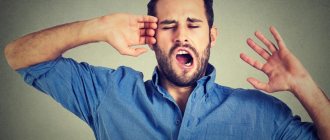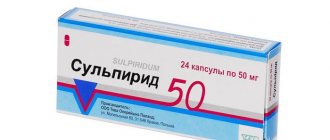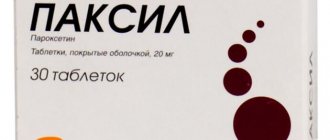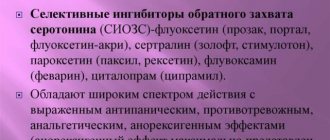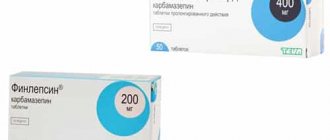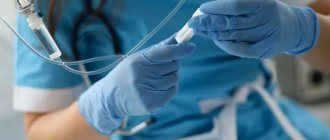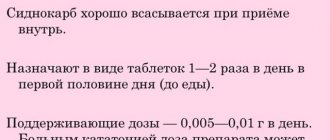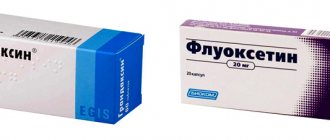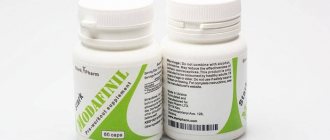To relieve attacks of epilepsy and prevent neuralgic pathologies, pharmacological agents with complex effects are used.
Finlepsin showed high effectiveness in therapy .
Achieving the desired therapeutic effect is possible only if you follow the rules for using the medicine, which can be found below.
Radar
The antiepileptic drug has been successfully registered and approved for sale in the Russian Federation.
The basic data entered into the help system contains the following information:
- INN – Carbamazepine;
- official trade name – Finlepsin;
- group of medications – antiepileptic;
- a substance that provides a therapeutic effect – carbamazepine;
- pharmacological actions of the drug - antipsychotic, antiepileptic, analgesic;
- dosage form – tablets;
- brief description – white round tablets, on one side of the plane there is a line, on the other there is a wedge-shaped depression, a chamfer around the circumference;
- packaging – 30/40/50 pcs. packaged.
Pharmacology
The therapeutic effect of the drug is achieved due to the physical and chemical properties of the main component of the composition.
Carbamazepine has a wide spectrum of action:
- antidiuretic;
- antidepressant;
- analgesic;
- antipsychotic
- antiepileptic.
The principle of operation of the drug is based on blocking voltage-gated sodium channels. This has a stabilizing effect on the membranes of overexcited neurons.
The therapeutic process is supported by a decrease in the manifestations of serial neuronal discharges and a decrease in the synoptic conduction of impulses.
Carbamazepine prevents the release of the neurotransmitter amino acid glutamate, increases the convulsive threshold of the central nervous system to normal, thereby minimizing the risk of developing an epileptic attack .
Can phenazepam be taken with alcohol: compatibility and consequences of using the drug
Phenazepam is a benzodiazepine tranquilizer, widely used in the practice of many doctors.
Its main advantages are proven effectiveness and availability. It is the drug of choice for mental and neurological diseases, various types of substance addiction, and in many other cases. But the drug also has negative sides. Phenazepam has a large number of side effects and contraindications. The most common side effect is drowsiness, but bradycardia, decreased blood pressure, dyspeptic disorders and much more also occur. A wide range of contraindications includes both certain diseases of internal organs and use in combination with other substances.
The compatibility of phenazepam with alcohol has been most studied. The fact is that the drug is used in the treatment of alcohol addiction. Some patients, after prescribing the drug, violate the instructions: they continue to drink alcohol, which causes a number of negative consequences, which are currently well studied.
Alcohol and phenazepam are completely incompatible with each other. The use of these two substances at the same time is strictly contraindicated. Neglecting these rules sometimes ends in death.
Phenazepam, like all benzodiazepine tranquilizers, increases the amount of inhibitory transmitters in the neurons of the central nervous system. This leads to inhibition of the activity of nerve cells and causes a sedative effect.
Ethanol has a similar effect. Its breakdown products are toxic to brain cells. First, they increase the concentration of substances responsible for pleasure, and then inhibit the activity of all central nervous system centers. The greater the dose of alcohol, the stronger the depression.
Phenazepam and alcohol potentiate each other's effects. However, the effect is not limited to conventional sedation. Any centers of the brain may stop functioning, including those responsible for vital functions. Drinking even small amounts of alcohol in combination with low doses of phenazepam can lead to significant depression of central nervous system cells.
The specific consequences depend on the dosage of the drug, the amount of alcohol and the sensitivity of the patient's body. Most often, general depression develops - confusion, stupor, stupor, coma, pathological drowsiness.
From the cardiovascular system, there is a pronounced decrease in heart rate and a drop in blood pressure. Reduced breathing may occur. Sometimes paradoxical reactions occur associated with hyperexcitation of the cerebral cortex and subcortical structures. Such reactions are called pathological intoxication.
Pathological intoxication is the development of symptoms of mental illness when drinking a small amount of alcohol. Accompanied by hallucinations, delusions, motor activity, and confusion. Sometimes convulsions develop, similar to an epileptic attack.
An overdose of phenazepam while drinking alcohol can result in death. The lethal dose of phenazepam is 10 mg.
Phenazepam is used to treat alcohol withdrawal, popularly called “withdrawal.”
Withdrawal syndrome occurs a few days after the complete cessation of alcohol consumption in people who have been abusing them for a long time.
It is manifested by attacks of aggression, agitation, unreasonable excitement, hallucinations, and delusions. This condition is treated with tranquilizers and other sedatives.
Contrary to popular belief, alcoholism cannot be cured with phenazepam. This drug only helps fight the symptoms that occur in addicts when withdrawing from alcohol.
Phenazepam is prescribed when alcohol withdrawal syndrome develops. This happens after it is completely removed from the body. In this case, the danger of interaction is eliminated. If the drug is prescribed to someone who is currently abusing alcohol, you should wait 2 days after drinking alcohol.
If, on the contrary, the patient wants to drink alcohol during treatment with phenazepam, regardless of the reasons for its prescription, you should wait a few days. The half-life of the drug is 12 hours.
This means that after 12 hours, half of the dose taken will remain in the blood. After another 12 hours - half half and so on.
Considering this fact and therapeutic doses, we can say that you should drink alcohol no less than 2-3 days after stopping treatment with phenazepam.
At the same time, it is worth remembering that you cannot stop taking the drug at once. Side effects may also develop when phenazepam is discontinued.
First, gradually reduce the dose of the medication, then stop taking it completely, wait at least 2 days, after which you can drink alcohol.
However, discontinuation of the drug must be agreed with the attending physician. Stopping treatment on your own can lead to serious consequences.
Reviews
Ilya E.: “I was treated by a narcologist for a long time for alcohol addiction. I couldn’t bear the lack of my favorite drinks very well, so I took phenazepam. The drug helped me cope with a difficult period in my life.
It suppresses irritability and calms well. I took it while I was in a bind. An excellent incentive not to drink, I saw what happens to those who drink phenazepam and alcohol at the same time. Apparently, they felt very bad, so I didn’t drink.
Phenazepam helped me cope.”
Kirill M.: “I took phenazepam prescribed by the doctor. I was warned not to drink alcohol, but I didn't take it seriously. This is how they talk about many drugs, and nothing happens.
During the course of treatment I had the imprudence to drink a glass of beer with friends. I don’t know what happened to me next. 4 days fell out of my life. As it turned out, I spent them in intensive care in an unconscious state.
I stopped taking Phenazepam, now I’m afraid.”
Review from a narcologist: “I often use phenazepam in the treatment of alcohol withdrawal. The drug is very effective, especially in patients with agitation, attacks of aggression, and insomnia. Phenazepam eliminates all these symptoms quite quickly.
I prescribe phenazepam only to those patients who are in the hospital, since they can be controlled, and I treat them on an outpatient basis with other medications.”
The use of phenazepam with alcohol is unacceptable. The effect of an already powerful tranquilizer is enhanced several times under the influence of alcoholic drinks, regardless of their strength. About what the consequences may be and how to avoid them.
What is this?
Phenazepam (bromodihydrochlorophenylbenzodiazepine) is a highly active tranquilizer with a strong muscle relaxant effect. It is available in the form of tablets or a white solution. You can buy it at any pharmacy, but strictly with a prescription from a doctor.
The drug eliminates feelings of anxiety, fear, tension and irritability. It is the most common tranquilizer in Russia, allowing you to cope with depression, nervousness and insomnia.
Main indications:
- panic attacks,
- sleep disorders,
- hypochondriacal syndrome,
- phobias,
- increased irritability,
- depression,
- schizophrenia,
- strong excitability, etc.
With regular use, outside of complex treatment, phenazepam is addictive. It is accompanied by aggressiveness and even more increased anxiety than before starting treatment. Its interaction with other drugs has not been fully studied to date.
Contraindications
Taking phenazepam is allowed only from 18 years of age. Unfortunately, many schoolchildren obtain this drug through illegal means and take it as a drug.
Contraindications:
- mental illness,
- cardiovascular pathologies,
- coma,
- states of shock,
- pregnancy and lactation period,
- taking drugs,
- alcohol consumption.
It should be taken with extreme caution in patients at risk of developing drug dependence.
Can phenazepam be taken with alcohol? No, drinking alcohol is one of the contraindications when taking phenazepam. Despite the fact that this is indicated in the instructions and must be communicated to the doctor when issuing a prescription, many do not stop drinking alcohol.
This is one of the most harmless consequences of mixing alcohol and phenazepam. It is accompanied by the following symptoms: brain fog, increased feelings of fear, nausea and headache. Hallucinations occur less frequently.
Phenazepam is often used to enhance the effects of alcohol consumption. The result is the rapid achievement of euphoria and the development of sustainable addiction. When taking such “cocktails”, a person does not control how much he has already drunk.
Each person's body is individual. It is impossible to predict his reaction to phenazepam along with alcohol. Severe allergic reactions are possible: surges in blood pressure, increased body temperature, depression of the respiratory system.
Large doses of phenazepam mixed with alcohol lead to loss of consciousness. Due to the rapidly developing effect of the tranquilizer, a coma cannot be ruled out. The chances of recovery in these situations are minimal.
Overdose
Exceeding the dosage of phenazepam as determined by your doctor is extremely dangerous for your physical and mental condition. If we add to this the effect of alcohol, then a number of irreversible consequences for the body are inevitable:
- dulling of self-control and feelings of fear,
- respiratory arrest,
- heart rhythm disturbances,
- the appearance of delusional ideas,
- involuntary urination,
- sudden weight loss,
- surges in blood pressure.
A person under the influence of phenazepam and alcohol is dangerous not only to himself, but also to others. He is not aware of what is happening around him, so he is capable of causing serious harm to other people.
The drug Phenazepam
Price
You can buy the medicine at the pharmacy or by leaving a request in the online store.
One of the main conditions for the sale of medications of this pharmacological group is the availability of a prescription in Latin.
Finlepsin Retard (400 mg) will cost 285 rubles .
The cost of regular Finlepsin is 206-219 rubles .
Storage and price
"Phenibut" can be stored at a temperature not exceeding +30 degrees. It remains valid for 3 years. Such storage conditions are provided for in the instructions for use. The price of Phenibut ranges from 150 to 600 rubles (for 20 tablets). The cost of the drug depends on the manufacturer.
Phenazepam tablets are stored at temperatures from +15 to +25 degrees. They are usable for 3 years. The price of the medicine in pharmacy chains is from 100 to 230 rubles (for 50 tablets).
Phenazepam is a strictly prescription medicine. When purchasing a tranquilizer at a pharmacy, the pharmacist puts a dispensing note on the prescription form.
Until recently, Phenibut was freely available from pharmacies. But now it has become a prescription drug. This is due to the fact that this nootropic is a stimulant of the nervous system and can have many side effects.
Indications for use
In the official instructions, the manufacturer indicates a number of pathologies, the treatment regimen of which may include the drug in question.
The medicine has received the greatest recognition in therapy:
- epilepsy;
- trigeminal neuralgia;
- diabetic polyneuropathy (with pain);
- idiopathic neuralgia of the glossopharyngeal nerve;
- multiple sclerosis (to prevent epileptiform seizures).
The active component of the drug is effective for various types of epilepsy, psychomotor/focal/partial/convulsive seizures and other symptoms characteristic of epilepsy and mental disorders.
Finlepsin increases the effectiveness of complex therapy for alcohol dependence.
The tablets eliminate seizures, insomnia, and stabilize the psycho-emotional background.
Instructions for use
Before starting therapy, it is important to read the instructions for the drug, in particular what the drug helps with and how to take it correctly. These factors are among the fundamental ones that ensure successful treatment.
The tablets should be taken orally, combined with meals. They can also be consumed after meals.
The pill should not be crushed into powder or chewed. The whole tablet is washed down with a glass of purified water.
The treatment regimen provides for a gradual increase in dose at the initial stage with a weekly increase in the initial amount of the drug by 50-150 mg.
The daily dose rate is determined taking into account the type of disease:
- For epilepsy, Finlepsin is included in complex treatment or used as monotherapy. In order to obtain a supporting effect, the daily norm for adult patients is 800-1200 mg. For medicinal purposes, it is recommended to start taking tablets with a minimum dose (200-400 mg), which is divided into 2-3 servings. The maximum rate should not be more than 2 g/day. Children under five years of age are prescribed 100-200 mg, from 5 to 12 years - 200-600 mg.
- Pain syndrome due to nerve pathology due to diabetes; the daily norm is 600 mg. Sometimes, to achieve the effectiveness of therapy, the doctor increases the dose to 1200 mg.
- Neuralgia of the glossopharyngeal nerve - the starting rate does not exceed 400 mg, then the dose is set within 600-800 mg per day.
- Epileptic convulsions due to multiple sclerosis - it is recommended to divide the daily dose of 400-800 mg into 2-3 servings.
- Alcohol dependence - therapy should begin with 600 mg, then the amount of the active component gradually increases to 1200 mg. The norm is divided into 3 servings.
- Psychosis - at the initial stage, experts advise taking 200 mg/day, then the rate increases to 800 mg.
To avoid complications, it is recommended to reduce the daily dose to the initial levels a couple of weeks before the end of therapy.
The duration of the treatment course or prevention in each case is determined by the doctor individually, taking into account the etiology of the disease, the intensity of changes, and the patient’s mental state.
A little about the differences
Before considering drug compatibility, you should familiarize yourself with the main differences between medications:
- Fluoxetine is an antidepressant that does not suppress nervous activity, but stabilizes the emotional background (Prozac, which is an indirect analogue of Fluoxetine, has a similar effect). As for Phenazepam, the medicine is a tranquilizer and has a relaxing effect on the nervous system, often causing drowsiness.
- Phenazepam is recommended to be taken at night to improve night sleep, but fluoxetine should be taken in the morning - this will help maintain a positive mood throughout the day.
- The duration of treatment with Phenazepam should not exceed 2 weeks (addiction to the drug appears), but fluoxetine can be taken for a long time, for several months.
- The therapeutic effect of using Fluoxetine is felt only on days 10-14, and after taking Phenazepam, patients feel a calming relaxation almost immediately (the tablet begins to act in 15-20 minutes).
The interaction between Fluoxetine and Phenazepam is harmless to the body and it is allowed to take the drugs together for the treatment of severe conditions.
Restrictions on use
The developers have identified a number of pathologies in the presence of which the use of drug therapy is not recommended.
Among the main ones:
- genetic liver diseases, especially at the acute stage;
- changes in bone marrow hematopoiesis;
- atrioventricular block;
- allergy to the components of the product;
- intolerance to tricyclic antidepressants;
- combination of carbamazepine with MAO inhibitors, pharmacological products containing lithium.
A group of patients has also been identified for whom Finlepsin is prescribed on an individual basis , taking into account possible threats.
The list includes people with the following health problems:
- thyroid dysfunction, Parhon's syndrome, reduction/cessation of hormone production by the pituitary gland;
- heart diseases;
- liver/kidney disorders, adrenal insufficiency;
- alcohol addiction;
- intense pathological changes in the central nervous system, obstacles created during the breakdown of carbamazepine, etc.
When prescribing the drug to older people, it is recommended to exercise caution.
Side effects
When testing the pharmacological agent, the following side effects were identified:
- unjustified aggression;
- hallucinations;
- changes in blood parameters (neutrophils, platelets, leukocytes);
- blood pressure surges;
- allergy;
- violation of sinus rhythm.
A negative reaction to carbamazepine from the urinary system cannot be ruled out.
Rarely observed:
- swelling;
- nephritis;
- hematuria;
- urination problems, etc.
Fluoxetine and Phenibut compatibility
The most common side effects of fluoxetine include dizziness, sleep disturbances, and irritability, especially at the end of the course of taking the drug. All these effects can be easily stopped by taking any sedative. Phenibut is able to eliminate all these negative reactions due to its anxiolytic component, and thanks to its nootropic effect, it also enhances the effect of an antidepressant.
These two drugs can be taken together, since they complement each other and potentiate (increase) the positive effect they have. The dosages of the drugs remain standard:
- Fluoxetine from 20 to 80 mg/day in 2–3 doses;
- Phenibut from 250 to 1000 mg/day in 3 to 4 doses.
Patients typically find it most convenient to take both drugs at the same time three times a day. The dose of medication is selected individually depending on the severity of the clinical symptoms of depression.
Finlepsin and alcohol: compatibility
Combining the use of antiepileptic drugs with ethanol is not recommended .
The action of the medicine is aimed at blocking depression and agitation, and alcoholic drinks cause them. This neutralizes the pharmacological properties of the active component and provokes the development of complications due to increased load on the liver and kidneys.
In addition, during the period of drinking strong drinks, the body actively reproduces the production of adrenaline, as a result of which the heartbeat increases and blood pressure increases. In this state, a person automatically falls into the risk group due to possible manifestations of spasms and hypertensive crisis .
Finlepsin is often included in a set of measures against alcoholism . The active substance of the drug blocks pathological cravings for drinking. This is important for patients who, after detoxification, have a strong desire to drink something from strong drinks.
Ignoring the warnings regarding the combined use of drugs and alcohol leads to liver dysfunction, intoxication of the body and other complications.
The negative impact of the toxic cocktail extends to the functioning of the brain and the hematopoietic system. If such problems occur, therapy should be interrupted.
You can restore the use of the product after cleansing the body of ethanol products.
Similarities between medications
If you compare Fluoxetine and Phenazepam, you can see that the drugs have almost the same indications for use:
- depressive states;
- unmotivated anxiety;
- unreasonable fears;
- obsessive states;
- chronic sleep disorders;
- alcohol withdrawal syndrome.
Both medications are available with a prescription, so they can only be purchased with a doctor's prescription.
Drugs are prohibited for pregnant and lactating women, for heart and kidney diseases.
Phenazepam is contraindicated in children under 18 years of age, and as for Fluoxetine, no studies have been conducted on the safety of children's bodies and the drug is also not recommended for children.
Reviews from patients who took the drug
Elena, 43 years old:
Trigeminal neuralgia was diagnosed a couple of years ago. Periodically you have to take pills to eliminate the symptoms of the disease. Periodically excruciating pain does not subside during the day or during the day. At the acute stage, a state of prostration is felt, which interferes with leading a normal lifestyle.
The doctor prescribed me the medicine Finlepsin. After taking the pills for a week, I felt significant relief.
The remedy also inspires confidence because it has long been practiced in neuralgia and psychiatry; experts have studied possible threats when used in complex therapy.
Igor Vladimirovich, 54 years old:
Finlepsin effectively eliminates symptoms of postherpetic intercostal neuralgia. This is my first time using the product; before this, the doctor prescribed 3 types of medications that did not provide the desired relief. Soon after the end of the course of therapy, relapses appeared.
The intensity of the action of Finlepsin tablets is amazing. After the first two days of taking the drug, the pain syndrome significantly decreased, and the rash that formed on the skin in the area of the affected nerve almost disappeared. In those places where there were already bubbles, a strong burning sensation was felt, but this phenomenon passed much faster than with the use of other medications.
The only side effects noted were drowsiness and slight dizziness.
What's better
To understand which is better, Phenibut or Phenazepam, you should consider the features of both drugs. The first medicine is less toxic and non-addictive. It can even be given to children, and the second drug is a potent and addictive drug.
Moreover, Phenazepam is quite poorly tolerated. When discontinuing the drug, symptoms similar to drug addiction occur, which are manifested by severe muscle weakness, withdrawal symptoms, memory loss and dizziness.
Therefore, most reviews from doctors and patients boil down to the fact that Phenibut is better than Phenazepam, which can even cause a pre-stroke condition. A nootropic, on the contrary, improves the functioning of the nervous system.
Analogs
Finlepsin and Finlepsin Retard have similar pharmacological properties. But upon closer examination of the annotations of both drugs, discrepancies are noted.
These differences can play a significant role in therapeutic treatment, so only a doctor should prescribe medication.
The main difference between the products is the prolonged action of the active substance Finlepsin Retard.
Changing the proportions of the composition ensures the gradual release of carbamazepine from the stomach, due to which the required amount of the chemical compound is maintained in the blood for a long time.
This reduces the risk of side effects and prevents relapses of epilepsy attacks.
When analyzing the degree of impact of the compositions of the drugs in question on the human body, it is impossible to answer unambiguously which drug is preferable to use in therapy. Only a qualified specialist can determine what is best.
Among the substitutes that have significant differences in the composition of drugs:
- Tegretol, Tegretol CR;
- Zeptol;
- Carbalex;
- Carbamazepine;
- Zeptol SR.
It is strictly prohibited to independently select an analogue or make changes to the dosage recommended by the doctor due to the high risk of developing side effects and reducing the effectiveness of treatment.
How to avoid feeling bad
It is impossible to completely prevent the manifestations of the syndrome; even with a decrease in dose, patients note a return of anxiety and panic attacks. Therefore, a gradual decrease in the amount should occur during treatment of the pathology. Therapy consists of a set of actions:
- Psychotherapy. Only working with a psychotherapist who has a medical education, not a psychological one, will help you forget about depression and neuroses. A person must change a lot in his thinking; this is the only way to treat psycho-emotional disorders. The specialist will teach you how to avoid hysterical attacks, panic attacks, and suicidal thoughts. It’s another matter if the diagnosis is psychiatric. Only medications will help here.
- Medicines. Antidepressants improve brain function, but they act very slowly, therapy lasts from several months to 1-2 years. That is why Phenazepam or Phenibut and other tranquilizers are prescribed before the drugs take effect, so that the person can rest and adequately perceive psychotherapeutic treatment. Therefore, it is logical to combine withdrawal with the start of taking antidepressants. In addition, you can additionally take natural sedatives, such as motherwort.
The main thing is a strong determination to forget about dependence on Phenazepam. Activities that bring positive emotions when a person forgets about everything can help in this difficult task. It is good if during this period the patient goes for sanatorium treatment in a specialized institution.
Direct withdrawal of the drug occurs gradually by reducing the dosage. The duration depends on the time of admission and the condition of the patient. First, the tablet is divided in half, then into 4 parts, into 6, 8 and completely removed. The doctor must determine how many days each stage will take. When this is not possible, you just have to rely on your feelings.
Conclusion
Phenazepam is part of a group of drugs, so the consequences of long-term use can be serious. Like any drug, the drug causes addiction and withdrawal upon withdrawal. This is one of the main reasons why it is not prescribed for more than 2 weeks. In the event of addiction, treatment should only take place in a hospital setting with experienced narcologists.
Benzodiazepines can be tapered off in increments of about one-eighth of the daily dose every two weeks (one-tenth to one-quarter). The daily dose can then be reduced in increments of 0.25 to 0.5 mg every two weeks. If unpleasant withdrawal effects occur, the dose should be held for a longer period until withdrawal symptoms further decrease. If necessary, dosage increases should be avoided. It's better to reduce too slowly than too quickly. The time it takes to eliminate the substance can vary from approximately 4 weeks to a year or longer.
The main purpose of this medicine is to provide a psychotropic and analgesic effect. “Phenazepam” is a very effective drug, but it cannot be taken uncontrolled; only a specialist can individually prescribe the dose and timing of use of the drug.


